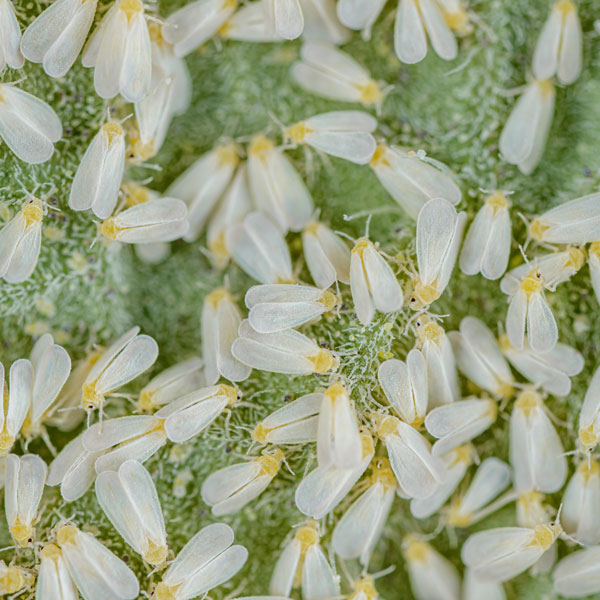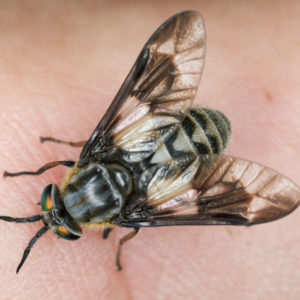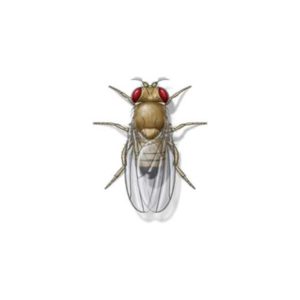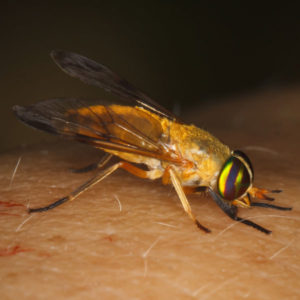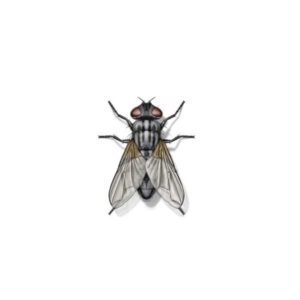Whiteflies, scientifically known as Aleyrodidae, are tiny, sap-sucking insects that fly around plants when disturbed. They are not true flies and are more closely related to scales, mealybugs, and aphids. Whiteflies derive their name from the mealy white wax covering the adult’s wings and body. These pests are more commonly associated with plants growing in greenhouses but also occur in plants grown in homes. All stages of whiteflies feed on plant sap, using their piercing-sucking mouthparts. Infested leaves can yellow and drop, reducing plant vigor, but usually not killing the plant. When infested plants are disturbed, great clouds of the winged adults fly into the air.
Unsure on the type of fly you are dealing with? Take a look at the most common flies found in North Carolina to help identify the specific fly species.
Whitefly Identification
What Do Whiteflies Look Like?
Whiteflies are characterized by their small size and distinctive white or pale yellow coloration. Adults typically measure less than 1/8 inch in length and have triangular-shaped bodies with four wings. Their wings are covered with a powdery, waxy substance, giving them a distinct white appearance. When disturbed, whiteflies flutter erratically, resembling tiny flakes of snow or dandruff.
Signs of a Whitefly Infestation
Signs of a whitefly infestation may vary depending on the severity of the problem and the type of host plant. Common signs include the presence of whiteflies on the undersides of plant leaves, where they congregate to feed and lay eggs. Infested plants may exhibit symptoms such as yellowing leaves, leaf curling, stunted growth, and premature leaf drop. Additionally, the sticky honeydew excreted by whiteflies can attract ants and promote the growth of sooty mold on plant surfaces.
Habitat, Diet, Lifecycle & Bites
Where Do Whiteflies Live?
Whiteflies can be found in a variety of habitats, ranging from agricultural fields and greenhouses to home gardens and indoor plantscapes. They prefer warm, humid environments and are commonly found on the undersides of leaves, where they feed on plant sap. Whiteflies are highly adaptable and can thrive on a wide range of host plants, including vegetables, fruits, ornamentals, and weeds.
Diet of a Whitefly
Whiteflies feed on plant sap by piercing the plant tissue with their needle-like mouthparts and extracting the nutrient-rich fluids. They primarily target the phloem, the vascular tissue responsible for transporting sugars and other nutrients throughout the plant. Continuous feeding by whiteflies can weaken plants, reduce their ability to photosynthesize, and predispose them to other stressors, such as diseases and environmental conditions.
Life Cycle of a Whitefly
The life cycle of a whitefly consists of four stages: egg, nymph, pupa, and adult. Female whiteflies lay eggs on the undersides of plant leaves, usually in circular or semi-circular patterns. The eggs hatch into tiny, wingless nymphs, which immediately begin feeding on the plant sap. As nymphs mature, they undergo several molts before pupating into adult whiteflies. The entire life cycle can be completed in as little as 2 to 4 weeks under favorable conditions.
Whitefly Bites
Whiteflies do not bite humans or animals in the same manner as mosquitoes or fleas. Instead, they feed exclusively on plant sap and are not known to cause direct harm to humans or animals through biting or feeding.
Are Whiteflies Dangerous?
While whiteflies themselves may not pose a direct threat to human health, they can cause significant damage to plants, leading to economic losses in agriculture and horticulture. In addition to feeding on plant sap, whiteflies can transmit plant viruses, further exacerbating plant damage and reducing crop yields. Severe whitefly infestations can result in the decline or death of host plants, especially in cases where the infestation remains unchecked.
How to Get Rid of Whiteflies?
To effectively get rid of whiteflies, begin by inspecting plants for signs of infestation, such as yellowing leaves or sticky honeydew residue. Use a strong stream of water to dislodge adult whiteflies from the foliage. Introduce natural predators like ladybugs or lacewings to help control the population. Remove heavily infested leaves or plants to prevent the spread of whiteflies. Regularly monitor plants for new infestations and take preventive measures, such as avoiding over-fertilization, to discourage future outbreaks. By combining these methods, you can effectively manage and reduce whitefly populations in your garden.
If you are dealing with a persistent whitefly problem on your property, contact your local fly exterminators.
Whitefly Prevention Tips
Preventative measures are key in reducing the risk of whitefly infestations:
- Monitor Plants Regularly: Inspect plants regularly for signs of whitefly infestations, such as yellowing leaves, sticky honeydew, or the presence of adult whiteflies on leaf undersides.
- Maintain Plant Health: Keep plants healthy and vigorous through proper watering, fertilization, and cultural practices. Healthy plants are more resistant to whitefly infestations and better able to withstand damage.
- Practice Good Sanitation: Remove and dispose of infested plant debris promptly to prevent the buildup of whitefly populations and the spread of infestations to nearby plants. Clean gardening tools and equipment regularly to prevent the transmission of whiteflies between plants.
Need help with White Flies control?
FAQs
Are Whiteflies Harmful?
While whiteflies themselves may not harm humans or animals, they can cause significant damage to plants, leading to economic losses in agriculture and affecting the aesthetic appeal of ornamental plants.
What Causes White Fly Infestation?
Whitefly infestations can be caused by various factors, including warm weather, high humidity, poor plant hygiene, and the presence of susceptible host plants.
Do Whiteflies Bite?
Whiteflies do not bite humans or animals. They feed exclusively on plant sap by piercing plant tissue with their mouthparts and sucking out the plant fluids.
How Long Do Whiteflies Last?
The lifespan of adult whiteflies typically ranges from several days to a few weeks, depending on environmental conditions and the availability of food and suitable breeding sites.

